The typical 30mm
PP base is not quite deep enough for the components I'm using, so I will usually scrape or sand away a depression to give that tiny bit of added depth. This isn't always essential as I usually file the bottom of the base flat when everything is finished anyway, but taking away a bit of plastic early on is easier and usually better than taking away metal later.
It's not obvious, but if you look you will see in this photo that I have carved out a shallow depression for the battery. I actually did this by scraping away plastic using the same chisel blade.

A good way to check if you've carved deep enough is to lay all the components - the battery and the two electrodes - on top of each other and then look at the base from the side to see if they protrude.
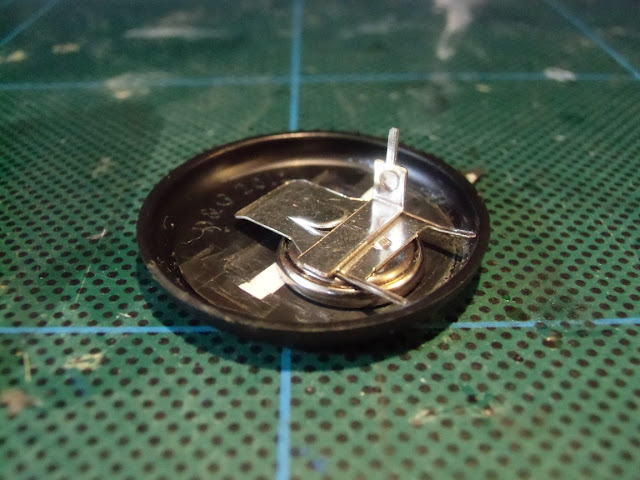
The next few bits are only needed if you are building a light-up base, you can skip them if you only need the base to hold the battery.
I actually scraped away a little bit of material around the rim for wires and LEDs using a small round file, but I'm not sure it actually mattered so you can probably skip this.

What is important though is to drill some holes around the rim that the LEDs will fit into. I used four for this 30mm base because it felt right. I would probably use four as well for a 40mm base, but might step up to six for a 50mm base if I ever do one - I might consider using two batteries at that point though since the base would be big enough. I guess it depends on the battery and the LEDs.
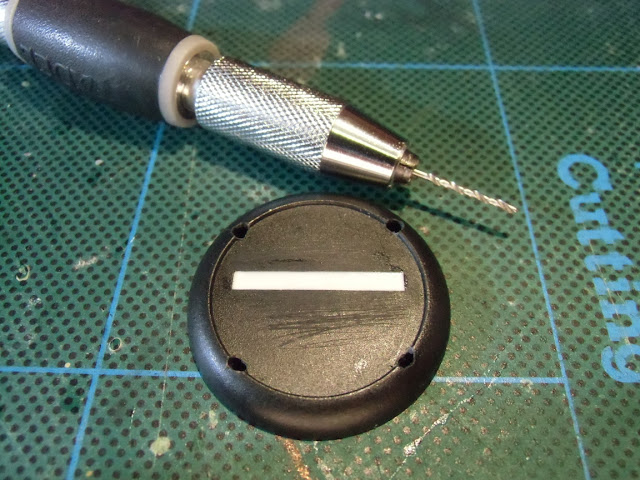
This is probably a good time to prime the base. We need a layer of white underneath the clear base topper to reflect the light upwards and illuminate the entire base topper. You probably don't need to worry about making the surface too uniform unless you are using a particularly clear base topper, but in that case you might want to paint something more complex on the surface as plain white might not look that good.
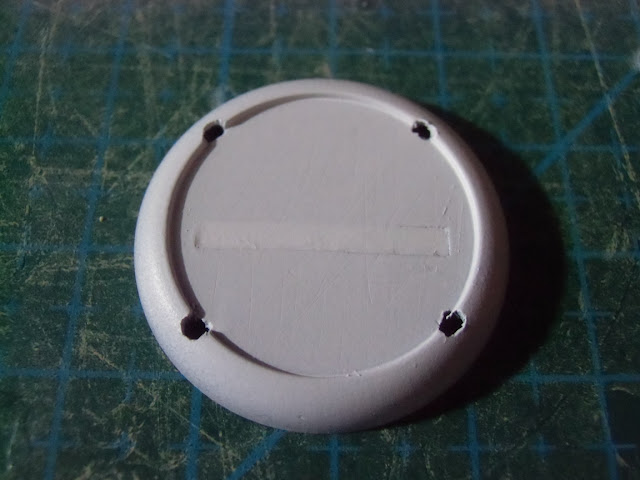
Now is probably a good time to mention that I use
CR 1220 batteries. These 3V batteries are about 2mm thick and 12.5mm in diameter. I like to use a compass cutter to cut a hole the size of the battery from 2mm plasticard.

I'm sure there's much easier ways of doing this; you can use a drill with a circle cutter or something if you have one. If you do use a compass cutter, it's important to spin it backwards: you want to carve plastic away using the back of the blade, not to try to cut into the plastic with the edge.

It's a rather time-consuming process - it probably takes me at least ten minutes - so use a drill if you have one and don't mind the noise. Either way, make sure you attach the plasticard to a disposable surface before cutting (bluetack works for me, but if using a drill you might need something stronger).

Now you want to cut the plasticard into a horse-shoe shape. I use clippers to do most of the work, and a hobby knife to clean it up.

Now back to the metal bits. We want to flatten the large thin piece. I usually snap the middle bit off with a pair of pliers then file the whole thing flat with a metal file. You probably don't need to worry about the two prongs though as the battery will probably not be sitting that deep in. You can leave the lip as well as this can help to slide the battery out of the holder when it's all done.
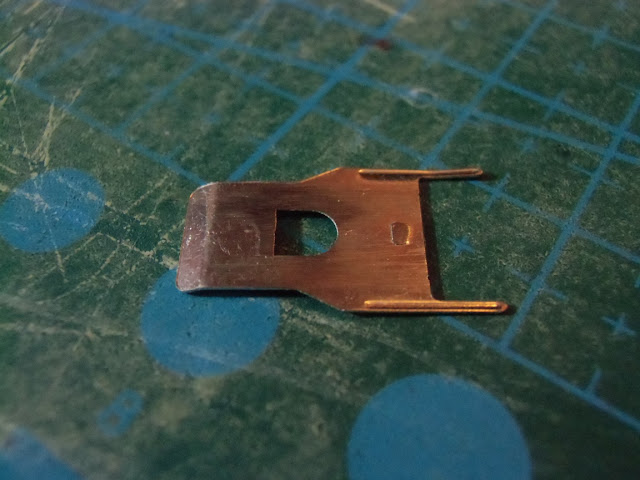
Next, take the small L-shaped piece.

We want to snap off the small tab and introduce a second bend into the shorter arm. I do this using two pairs of needle-nosed pliers, but the fact is it's a very fiddly job. It can be hard to get the height right; it's probably better if it's a bit lower than higher. I often have to do this two or three times to get it right, so be patient and have spares ready to go.

It may be necessary to cut the long arm down a bit; if this piece will be attached from the side you won't need to do this, but if it's coming straight down you might. Sorry if that doesn't make much sense just yet, but hopefully it will soon.

Now a quick word on soldering. I like to use a gas-powered soldering iron because I find that they heat up more quickly, you can control the temperature to some degree, and the shorter neck and lack of a cable sticking out the back makes it easier to do precise work. However, they do have jets of very hot air shooting out of the sides, so if you're not careful when soldering the hot air can melt the plastic of the base. I recommend holding the soldering iron as vertically as possible when soldering bits that area already stuck in place.
I got my soldering iron from Radio Shack several years ago, and I love it. I've found a little clamping stand (I think they go by the name "helping hands") to be invaluable for this kind of fine soldering work. As you can see I'm using laminated copper wire; I think the stuff I'm using is about 0.4mm diameter. Remember to scrape the lamination off the tips before soldering.
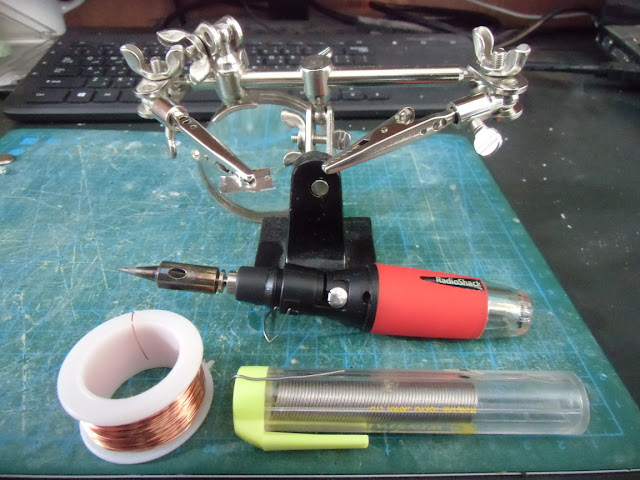
Of course it helps to do as much soldering as possible before the bits are stuck in place, as this reduces the chance of melting anything.

First the large piece is glued down. A rough surface can help this to stick well, but of course the surfaces are probably already rough from all the filing and sanding we've been doing.

Next we stick the plastic horse-shoe in place. Remember to carve it down as much as possible to leave room for other components, and to make sure to position it to hold the battery in exactly the right position. You will probably need to do some carving on the bottom for the electrode, otherwise it will not sit flat.

In this case I've soldered the switch in place before gluing it in. What you do here depends on the layout of your base of course. I just use small sliding switches from Ebay.
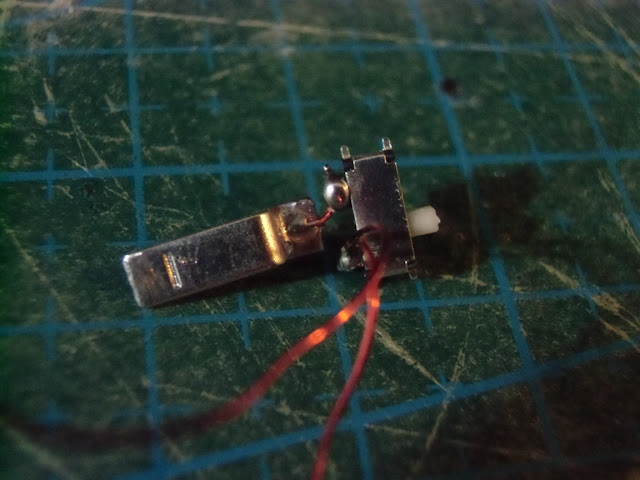
Now we glue the top electrode in place. This is what's going to hold the battery in, so try to attach it as securely as possible - I like to apply glue to the surrounding area then press some putty in place and give it a day to harden completely before I actually start sliding the battery in, to make sure the connection is strong enough to withstand the stress.
Notice that in this base I've glued the top electrode so it's pointing in the direction that the battery slides in and out; as mentioned above I had to shorten this one to make sure the battery could be taken out.

As you can see in this photo, it's also possible to have this piece pointing perpendicular to the direction that the battery slides in and out. This is often easier and you won't need to shorten it, but you do need to make sure to put it far enough from the edge of the base that the battery can be removed - the battery tilts as it slides out so if the electrode is too close to the edge of the base it will get in the way. The reason why I used the first method in this case was because that left me more room for the LEDs and wires around the rim.
